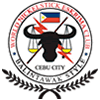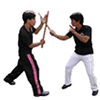


Philosophy and Training Methodology
Balintawak Methodology, by GM Nick Elizar
Balintawak is defense oriented. We assume automatically that our opponents are skilled. Because of this, skills in defense are first perfected. Once timing and speed in defense are fully developed, progress in the offense is automatic. When both defense and offensive skills become flawless, fluidity in movement is achieved. It is here that one’s skill as a eskrimador becomes true. This is the essence of Balintawak.
Balintawak has always trained its students one on one. Whether it be a beginning-advance student training a fresh beginner, or a master training an advance fighter, Balintawak has consistently produced effective eskrimadors through this method. Because of this individualized training, learning becomes efficient and with purpose. The realization of the detailed subtleties of the art is grasped quicker by students of Balintawak.
The concept of agak is central to Balintawak’s training method. Literally, this Cebuano word means to guide and assist. When a skilled guide, familiar with the local terrain, helps a weaker, less knowledgeable person, taking him by the arm to maneuver through a raging river during a downpour to cross to the other side—this is agak. So, it is with this philosophy in mind that Balintawak transfers its knowledge of eskrima from master to instructor and from instructor to student.
During the days of Venancio “Anciong” Bacon, training was straight to the point. In the very first day, the student was handed a stick (olisi or garote in Bisaya), was given the “on guard” warning, then he was struck. The student was free to use any defensive maneuver he so wished. After the student was hit, he was then taught the correct method of which to defend himself for that particular strike. Specific techniques were also introduced in the same manner. This was Venancio Bacon’s method of teaching, which he perfected, producing many notable master eskrimadors.
His most noteworthy student, Jose Villasin, unable to copy the nuances of Anciong Bacon’s teaching method, decided to systematize the more salient aspects of Balintawak. He created the grouping system, which he and his close friend Teofilo Velez would use to train their students in Balintawak. The essence of Balintawak was still transferred from instructor to student, the only difference was the system now employed to transfer this knowledge. With this system, there is a clear progression from which the student could effectively gauge his knowledge of Balintawak.
The student is first introduced to the 12 basic strikes. Strike 1 and 2 are to the left and right temples. Strike 3 and 4 are to the left and right elbows, or rib cage. Strike 5 is a thrust (or tochada) to the solar plexus. Strike 6 and 7 are thrusts to the right and left shoulders. Strike 8 and 9 are to the left and right knees. Strike 10 and 11 are thrusts into the right and left eyes. The last strike, strike 12 is to the top of the head. These strikes have to be performed with correct leg positioning to maximize balance, thus achieving power, speed, and maneuverability with each individual strike.
That student is then introduced to the 12 basic defenses for each strikes. For every defense, the student is taught to move the stick in tandem with his left hand, while purposefully shifting his balance. Once the strike is deflected by the student’s stick, his left hand controls, “feeling” his opponent’s stick while delivering the proper counter strike. This will serve as the student’s first introduction to the purpose of Balintawak’s alive hand. Again, as with the 12 basic strikes, the 12 basic defenses require correct positioning of the legs to ensure proper balance. This in turn will create the proper foundation for power, speed, and movement.
Once the basics are out of the way, agak begins in earnest. The student is introduced to the grouping system. This is first done through palakaw, or to walk through. The student is first “walked through” the grouping method, to ensure proper execution of all the basic movements, paying close attention to his leg positioning and overall body movement. The student is delivered a strike, in which he is to defend, then check or clear the instrutor’s stick, finally delivering the proper counter strike. The instructor receives the students counter strike, then clears it and delivers another strike to the student. All 12 strikes and all 12 defenses to these strikes are all used by the student during this exercise.
Throughout, the palakaw, the instructor is making corrections to the student’s overall movement pattern. But, more importantly, the instructor is gauging the student’s development, increasing his speed and power for each strike delivered. As the student’s reflexes become sharpened, the instructor begins to add the groups to the exercise. Eventually, this exercise morphs into the padagan, or to run through, as the intensity of the training heightens. The student is constantly bombarded with strikes delivered randomly by the instructor, who never lets up until the student begins to lose control of his own stick, at which time rest is awarded.
The groups are then systematically added into the padagan. The groups are forms of attacks used by the instructor to teach the student certain movements he will need to master. The first of these movements, require the student to use his left hand, specifically to grab, lift, and clear. Next, the student is introduced to the instructor’s butt of the stick, or pok-pok in Bisaya. The student is now required to bob, while deflecting his opponent’s pok-pok with his left arm. The third group of movements, are the various angles of tochadas, or thrusts, delivered by the instructor. Here, the student is expected to weave away from the thrusts while deflecting and countering. The fourth group involves abaniko style strikes. The student is trained to duck and twist his torso to avoid and block the strikes. The fifth, and last group, involves trapping and punches, familiarizing the student to traps while perfecting his parrying.
The individual groups of movement are inserted sporadically throughout the padagan, serving as the framework for other various possibilities of attack. The instructor at this time is analyzing and probing the student for strengths and weaknesses. His goal is to finely tune his student, dissecting his movements and removing all flaws that will prove costly in an actual violent encounter. The cowering of the eyes are the most common of these flaws, to include rigidity of the body, unnecessary tensing of the muscles and improper balance. The moment the instructor feels the student is ready, he will instinctually increase the level of the training.
As the student progresses, he is expected to cultivate an individual fluidity of movement, which will increase his ability to perform power strikes at any angle with utmost speed. Fluidity of movement will also increase the student’s ability to block or evade strikes from his opponents. After achieving the very basic level of this endevour, the student is introduced to pakgang, which will acclimate him to his instructor’s many options of counter. The student will also become familiar with the witik, which the instructor utilizes to constantly improve his student’s defensive reflexes. The instructor will also introduce sweeping, kicking, disarming, pushing, pulling, butting, tripping, locking, kneeing, elbowing, punching, chopping, throwing, and head-butting into the padagan, familiarizing the student with more defensive and offensive possibilities.
There is also an empty-hand version of the padagan which uses much of the same movement without the stick. The student will realize that without a weapon, the skills he already learned are still very effective, because the stick is an extension of his arm. Specifically, the empty-hand padagan trains the student in the various entangling techniques, in addition to many lockings. Knife training focuses first in the avoidance of this attack. The student is taught to weave and twist away from the direction of the knife. Eventually, he will be able to apply the various disarming, locking, and hitting techniques he has learned from the padagan.
At the advance stages, the differentiation between student and instructor fades. It is at this level that sana-sana begins, introducing the student to the concept of cuentada, or calculation. Unbeknownst, to the student the components of sana-sana has already been introduced to him in the padagan. Cuentada involves the anticipation of your opponent’s offensive intent, while effectively countering his movement with a specific technique meant to produce finishing moves. At the heart of cuentada is the fighter’s ability to “read” his opponent’s attacks, while he in turn makes his own intent non-telegraphic. It requires impeccable timing, flow, and the ability to disrupt the opponent’s rhythm. It is here that the student begins to understand Balintawak.
Although the basic student curriculum can be taught in 6 to 12 months, assuming the student trains regularly with a very qualified instructor, the quest for perfection in Balintawak never ceases. The philosophy of Speed, Power, Elegance, Fluidity, and Economy of Movement by Venancio Bacon has been transferred. This package of skills comes complete, all unnecessary movements and techniques still apparent in many systems are absent in Balintawak. Simplicity is at the core of Balintawak. It has been tested, it has stood its ground. Balintawak will always stay faithful to this philosophy. There are no costly stick twirling lessons, since our intent is to train fighters.